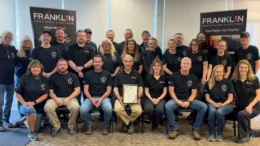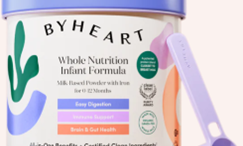This article is an overview of growing and using garlic, including six recipes.
Many excellent varieties of garlic (Allium sativum) may be grown in Pennsylvania. Purchase garlic seed (bulbs) for planting from a local grower, gardener, garden center or seed catalog. Stiffneck (hardneck) varieties grow best. They are more cold-hardy than the softneck types that are used for braiding. Stiffneck garlic may be identified by the hard stem at the top center of the bulb. Plant individual garlic cloves (pointy end up) 1 to 2 inches deep in a sunny location with well-drained garden soil in mid- to late-October. Space cloves 6 to 7 inches apart in rows, and allow 1 foot between rows. Lightly mulch the bed with straw to prevent winter heaving and to suppress weeds during the growing season. Fertilize in March and control weeds throughout the growing season. Garlic needs adequate water to develop, so irrigate when rain has not been forthcoming. In June, scapes (the elongated flower stalks) will appear, emerging through the top of the foliage.
Harvesting Garlic
To improve bulb size, remove the scapes while they are young by cutting or snapping them off where they emerge from the top leaves. Scapes are wonderful to eat and may be allowed to grow and coil before removing them. Harvest scapes before they begin to straighten and become stiff. The garlic bulbs are ready to be harvested from early- to mid-July. If harvested too early, the bulb size will be smaller. If harvested too late, the bulb will split. Harvest when the leaves begin to brown and at least 4 leaves are still partly green. Reduce watering as this time approaches. Do not pull the stem to harvest. Instead, use a spade or shovel to lift the bulb from the ground. The bulbs are tender and easily bruised when first harvested. Use immediately or cure for long-term storage. Allow them to dry and harden in a well-ventilated, shaded area for a few weeks. Then, clean by brushing away loose dirt. Remove one layer of the bulb wrapper, trim the roots close to the wrapper, and cut the tops off 1 inch from the bulb. Set aside the largest uniform bulbs for replanting. For more information on growing garlic go to this link, https://extension.psu.edu/garlic-production.
Using Garlic in the Kitchen
Garlic Greens
Young garlic leaves, or greens, may be used in salads, sauces, and soups. If you want to eat the garlic greens, grow separate plants for this purpose since the plant needs the leaves to produce a bulb.
Garlic Scapes
The scapes from stiffneck garlic may be used for culinary purposes, including pesto, stir fry, and omelets. Remove the top flowery part, as it contains pollen and may inadvertently cause an allergic response. Leave the rest whole for roasting, or chop and use raw or sautéed in casseroles, soups, sauces and salads.
Garlic Bulbs
Fresh garlic cloves may be used raw or cooked; whole, minced or crushed. Roasting garlic results in a fragrant, sweet flavor, different from other cooking methods. Preserve garlic by slicing or chopping and then drying with a dehydrator for garlic chips, garlic powder or garlic salt.
There are no safe methods for canning garlic. For complete information on storing and preserving garlic bulbs, see Garlic: Safe Methods to Store, Preserve, and Enjoy – University of California. https://ucfoodsafety.ucdavis.edu/sites/g/files/dgvnsk7366/files/inline-files/250352.pdf
Recipes
For all recipes, start with clean counters and utensils. Wash hands for 20 seconds and dry with a single-use paper towel.
Dried Garlic
Peel garlic cloves, and slice or chop finely. There is no need to blanch. Spread on parchment paper over dehydrator trays. Dry until crisp, about 6 to 8 hours. Garlic is very pungent, so provide adequate ventilation or place the dehydrator outside, if a protected/covered area is available. Store dried vegetables in air-tight containers to prevent food from absorbing moisture in the air. Dried garlic chips have many uses in the kitchen. Alternatively, use a blender, mini-grinder or mortar and pestle to make powder. To make garlic salt, mix 1 part garlic powder with 4 parts salt.
Garlic Infused Oil
Garlic is a low-acid vegetable and caution must be taken when infusing oil with garlic. Specific processes must be followed to ensure that conditions are not created which support the growth of the bacteria which causes deadly botulism toxin. For safe research-based information, go to: How to Safely Make Infused Oils. https://extension.psu.edu/how-to-safely-make-infused-oils
Garlic Scape Pesto
- ¼ lb. garlic scapes (about 2/3 cup, chopped)
- ¼ cup pine nuts, toasted and finely chopped (optional)
- 1 cup grated Parmesan cheese
- 3 tablespoons fresh lime or lemon juice
- ½ cup olive oil
- Salt to taste
Puree scapes and olive oil in a food processor until smooth. Stir in pine nuts, Parmesan cheese and lime or lemon juice, and season to taste. Serve on bread, crackers or pasta.
Classic Pesto (makes 1 2/3 cups)
- 2 large cloves garlic
- 2 cups pine nuts
- 3/4 cup grated Parmesan cheese
- 2 cups packed fresh basil leaves
- 2/3 cup olive oil
Blend basil and garlic into a fine paste in a food processor. Add pine nuts and Parmesan cheese and blend. With machine running, pour in olive oil and mix until creamy and smooth. Can be frozen in useful amounts in airtight containers or freezer quality plastic bags.
Spinach & Garlic Scape Salsa with Salmon
Salsa:
- 2 cups spinach (preferably baby), rinsed & dried
- ½ cup chopped garlic scapes
- ¼ cup parmesan cheese
- ¼ cup olive oil
- 2 tablespoons butter
- salt & freshly ground black pepper
Salmon:
- 2 lbs. salmon fillets, on the skin
- 1 tablespoon olive oil
Place spinach, scapes, and Parmesan cheese in food processor and pulse until mixture is chunky. With machine running, pour in olive oil. Process until mixture is smooth. Add butter, salt and pepper, and mix. If you didn’t ask the fish monger to slice the salmon into scallops (long slices) then do it yourself by placing a carving knife at a 45-degree angle and slice down through the raw salmon to the skin but not through it. Now place your knife at a 45-degree angle and remove the scallops from the skin; discard the skin. Place the scallops on a plate and cut each long slice into 2 inch pieces. Heat oil in non-stick skillet. Season salmon and place flesh side down; fry 1 side only for 1 minute or until browned. Flip salmon onto baking sheet, browned side up. Spread some salsa on top of salmon. Bake in a preheated 450°F oven for 1 or 2 minutes—just until white juices begin to appear.
Carol Burnett’s Scampi
(From Eat This…It’ll Make You Feel Better by Dom DeLuise)
- 2 tablespoons olive oil
- 2 tablespoons melted butter
- ¼ cup lemon juice
- pepper to taste
- 3 tablespoons shallots, finely minced
- 3 garlic cloves, finely minced
- 2 pounds jumbo shrimp or prawns, shelled and deveined
- lemon slices and parsley for garnish
Combine olive oil, melted butter, lemon juice, pepper, shallots, and garlic in a shallow baking dish. Add shrimp and turn several times to coat thoroughly. Place the dish of shrimp in a preheated broiler about 4 inches from the heat for about 2 minutes, turn and broil on the other side for 1 minute more. Don’t overcook. Arrange on a serving platter and pour remaining cooked sauce over the shrimp. Garnish with lemon and sprinkle with parsley. Serve hot.
Garlic Bread
- Crusty Italian or French bread, thickly sliced
- Butter, softened
- Garlic cloves
- Parmesan cheese, grated
Arrange bread slices on top of a broiler pan. Crush one garlic clove for each bread slice and mix into softened butter. Spread on top of bread slices and sprinkle with grated Parmesan cheese. Toast under broiler until lightly browned.
Oven-roasted Garlic
- Aluminum foil
- ½ tablespoon olive oil (per bulb of garlic)
- Salt and pepper
- Optional: sprigs of thyme and/or bay leaf
Preheat oven to 350°F. Wash garlic bulbs and pat dry. Remove outer wrapper leaves. Keep the bulbs whole, but cut through the wrapper across the top of the bulb to expose the tips of the cloves. Cut 2 pieces of regular foil or 1 sheet of heavy-duty foil to wrap each head of garlic. Place the garlic bulb on the foil, cut side up, and drizzle with ½ tablespoon of olive oil. Season with salt and pepper and add herbs, if desired. Wrap tightly. Roast for 30-60 minutes or until the package gives when pressed. Unwrap and serve warm or at room temperature. The clove wrappers can be peeled away or squeezed to remove the roasted garlic.
Authors
Susan Marquesen
Master Gardener and Master Food Preserver
Allegheny County
Lyn Lang
Master Gardener
Allegheny County











































